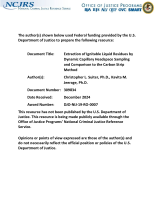Research and Evaluation for the Testing and Interpretation of Physical Evidence in Publicly Funded Forensic Laboratories Program
Forensic Biology Protocols for Molecular Serology Manual
Working Towards Implementation of Whole Genome Mitochondrial DNA Sequencing into Routine Casework
Forensic analysis of small architectural and vehicle glass fragments using recent developments in μXRF technology
Interpreting DNA under fingernails given activity level propositions
Validation of a Confirmatory Proteomic Mass Spectrometry Body Fluid Assay for Use in Publicly Funded Forensic Laboratories
ANSI/ASTM E2926-25 Standard Test Method for Forensic Comparison of Glass Using Micro X-ray Fluorescence (µ-XRF) Spectrometry
Assessing the value of bacteria, plants, fungi and arthropods characterized via DNA metabarcoding for separation of forensic-like surface soils at varied spatial scales
Development of a spectral X-ray fluorescence database to strengthen the scientific foundations for the forensic analysis and interpretation of modern soda-lime glass
Recommendations for the forensic analysis and interpretation of glass from contemporary portable electronic devices by refractive index measurement and micro-X-ray fluorescence spectrometry
Assessing the expanded capacity of modern μ-XRF SDD systems for forensic analysis through an interlaboratory study: Part II—Vehicle glass
Development of a spectral X-ray fluorescence database to strengthen the scientific foundations for the forensic analysis and interpretation of modern soda-lime glass
Development and evaluation of methods for objective comparison of x-ray fluorescence spectra
Reporting the value of biological findings given activity level propositions: A discussion of published recommendations
The New DNA: Recommendations for Agencies to Consider Implementing to Improve Digital Evidence Processing and Analysis
Proteomic Analysis of Single Hairs
Cross-reactivity in urine of 53 cannabinoid analogs and metabolites using a carboxylic acid enzyme-linked immunosorbent assay (ELISA) and homogenous enzyme immunoassay (HEIA) kit and immunalysis synthetic cannabinoid HEIA kits
Assessment of the Added Value of New Quantitative Methodologies for the Analysis of Surface Soils in Forensic Soil Comparisons
The analysis of glass from portable electronic devices and glass accessories using µ-XRF for forensic investigations
Characterizing Stutter in Single Cells and the Impact on Multi-cell Analysis
Integration of a High-resolution Melt Curve Assay into a Commercial Quantification Kit for Preliminary Identification of Biological Mixtures
Evaluation of the Incorporation of µ-XRF SDD Systems in Analytical Workflows of Black Electrical Tapes
Extraction of Ignitable Liquid Residues by Dynamic Capillary Headspace Sampling and Comparison to the Carbon Strip Method
Evaluation of Cannabis Product Mislabeling: The Development of a Unified Cannabinoid LC-MS/MS Method to Analyze E-liquids and Edible Products
NIJ Announces $1.1M to Fund Research in Public Forensic Laboratories in 2024
On September 20, 2024, NIJ announced $1.1 million in funding to support three new projects under its Research and Evaluation for the Testing and Interpretation of Physical Evidence in Publicly Funded Forensic Laboratories (Public Labs R&E) program. Through its forensic science research funding, NIJ continues to improve the examination and interpretation of physical evidence across the community of practice through identification of the most efficient...



